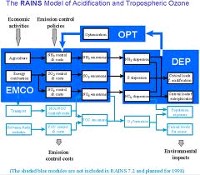The RAINS Model
The agreement will also be a milestone in the application of science to international policy. For the first time, negotiators have addressed a complex range of related air pollutants and problems jointly in one round of negotiation rather than discussing them in separate talks and protocols. This profound change in approach has been possible only because negotiators had the support of the sophisticated computer model RAINS—the Regional Air Pollution and Simulation model.
It is no exaggeration to say that without a model like RAINS, the new multi-pollutant agreement could not have been negotiated. The cross-linkages among polluters, pollutants, and environment are numerous and complex, and the range of possible trade-offs in the economy and environment is potentially overwhelming. RAINS organizes key information on science, policy options, and costs in one package. It helps negotiators avoid getting sidetracked in scientific minutiae nd allows them to concentrate on the search for policies (or, more accurately, combinations of policies) that provide the best balance of environmental protection at the lowest possible costs.
RAINS was the first computer model to ever be placed at the center of negotiations
for a major environmental agreement: the 1994 agreement by 35 countries to limit sulfur dioxide emissions in Europe. Subsequently, RAINS played a central role in the creation of the European Commission’s 1995 Acidification Strategy. More recently, it supported the development of new, legally binding EU directives on air quality and emissions; those directives should be published in late 1998. And, as mentioned above, RAINS is central to joint efforts by EU member countries and the nations of Central and Eastern Europe to sign a truly comprehensive agreement covering four major pollutants.
With some 900 copies of RAINS delivered to governments, private firms, academic
institutions and environmental NGOs in over 50 countries on four continents, RAINS is one of the most successful integrated assessment tools yet devised.
This role—helping governments to identify scientifically sound, cost?effective policies to
combat air pollution—precisely fulfills the task envisaged for RAINS by the IIASA scientists who conceived the model in 1983.


